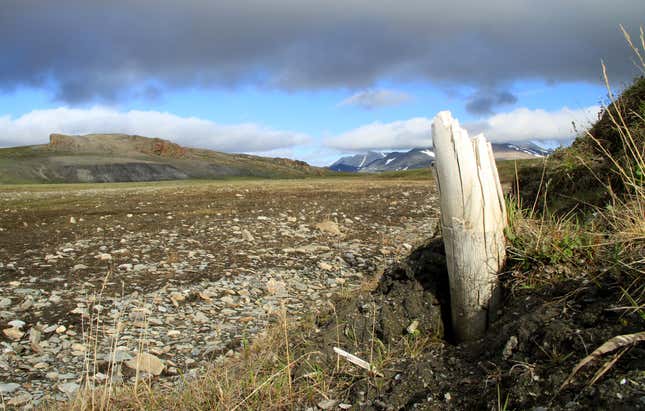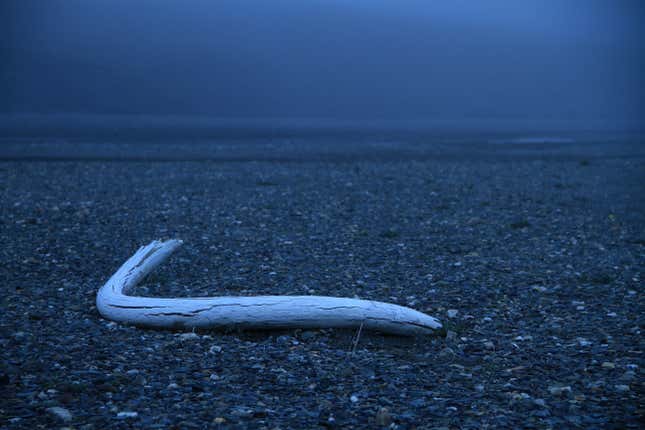The last mammoths to walk the Earth did not succumb to inbreeding after hundreds of generations, despite being stuck on a remote island off the coast of Siberia. That’s the finding of research published today in Cell which interrogated 21 woolly mammoth genomes to understand how the population’s genetic diversity may have played a role in the massive proboscideans’ extinction.
Woolly mammoths (Mammuthus primigenius) were a large elephant cousin, adapted for cold and famously covered in shaggy hair. The last mammoths persisted on Wrangel Island, a spit of land north of Siberia that was cut off from mainland Asia about 10,000 years ago when sea levels rose. The Wrangel Island mammoths died out so recently that they shared the planet with the Great Pyramid of Giza, built in Egypt around 2560 BCE. But the circumstances of their extinction are shrouded in mystery; while the new study does not pinpoint the cause of the animals’ disappearance, it finds that reduced genetic diversity was not the root cause.
“Genetic diversity in a population is very important for resilience against environmental changes,” said Marianne Dehasque, a geneticist at the Center for Paleogenetics in Stockholm and lead author of the study, in an email to Gizmodo. “We think something very short and sudden must have caused the last mammoth population’s demise,” Dehasque added, but “until we have a genome closer to the mammoth’s extinction, it remains speculative on what exactly happened.”

The team analyzed 21 high-coverage mammoth genomes, ranging in age from approximately 52,300 years ago to just 4,333 years ago, shortly before the species’ extinction. Fourteen of those genomes were from individuals on Wrangel Island and seven were from Siberian populations that predated the island’s separation from the mainland. They conducted simulations of the Wrangel Island mammoth population to figure out the potential scenarios of the populations’ origins, as well as how it swelled and shrunk over the generations. The researchers concluded that the most likely scenario is that the Wrangel Island population started with just eight individuals, give or take a few. After this near-extinction event, the Wrangel Island mammoths rapidly swelled to several hundred individuals over the next 20 generations and persisted for another 6,000 years before the animals’ actual disappearance from Earth.
“We can also see in the genomic data that individual mammoths were affected by harmful mutations for thousands of years after the bottleneck, although this so-called inbreeding depression was not severe enough to cause the population to gradually decline towards extinction,” said Love Dalén, an evolutionary geneticist also at the Centre for Paleogenetics and co-author of the paper, in an email to Gizmodo. “Overall, these results refute earlier hypotheses that genetic problems caused the extinction, and instead point toward a rapid change in the environment as the cause of the extinction some 4,000 years ago, such as a disease, climatic perturbation, or wildfire.” It’s surreal to think that if not for some disease outbreak or wildlfire mammoths would still be roaming our planet today, but that is the possibility suggested in the recent paper.
Dalén noted that most living things give birth to more offspring than needed to keep a steady population, but various factors can reduce the population size and cause inbreeding depressions and genetic drift. Though individual mammoths may have experienced negative effects of this inbreeding, the population as a whole was able to shoulder any harmful effects. According to the paper, the Wrangel Island populations showed signs of purging the most harmful mutations from its genetics, but kept accumulating mildly harmful mutations until the animals’ extinction.

Besides their genetic information, mammoth tusks lock away troves of information about the prehistoric proboscideans and they ways they lived their lives, from the foods they ate to the other mammoths they fought. Earlier this year, a team tracked the movements of a 14,000-year-old mammoth through Alaska based on isotopes in its tusk; back in 2021, a team including Dalén and Dehasque found the oldest DNA yet from a million-year-old mammoth tusk.
Though the research does not resolve what happened to the last mammoths, the team is getting closer to an answer. They plan to next tackle even younger mammoth DNA—that is, mammoths that lived closer to the moment of extinction.
“We have a few mammoth samples that are around 4,100 years old,” Dehasque said. “The DNA quality in these samples is not great, but as methods are constantly improving, we will hopefully have genome data for at least one of these samples soon.”
While the nail in the coffin for the Wrangel Island mammoths remains unclear, the writing was on the wall for the species. A 2021 paper published by a different team of researchers found that climate change—our planet’s egress from the last Ice Age, as opposed to the more rapid, anthropogenic warming we see today—reduced the food sources of mammoths, eventually causing their demise.
Inching closer to the moment of extinction, paleogeneticists are gaining a clearer understanding of exactly what caused the Ice Age giants to vanish. Whatever the cause, it may have lessons for other small animal populations today, like the adorable, highly inbred kākāpō of New Zealand, and the vaquita of Baja California, of which only about 10 remain.
Extinction sometimes happens slowly, but then all at once. The ancient case of the woolly mammoth appears to follow that trend—but what finally killed off the hairy giants remains to be seen.




















+ There are no comments
Add yours